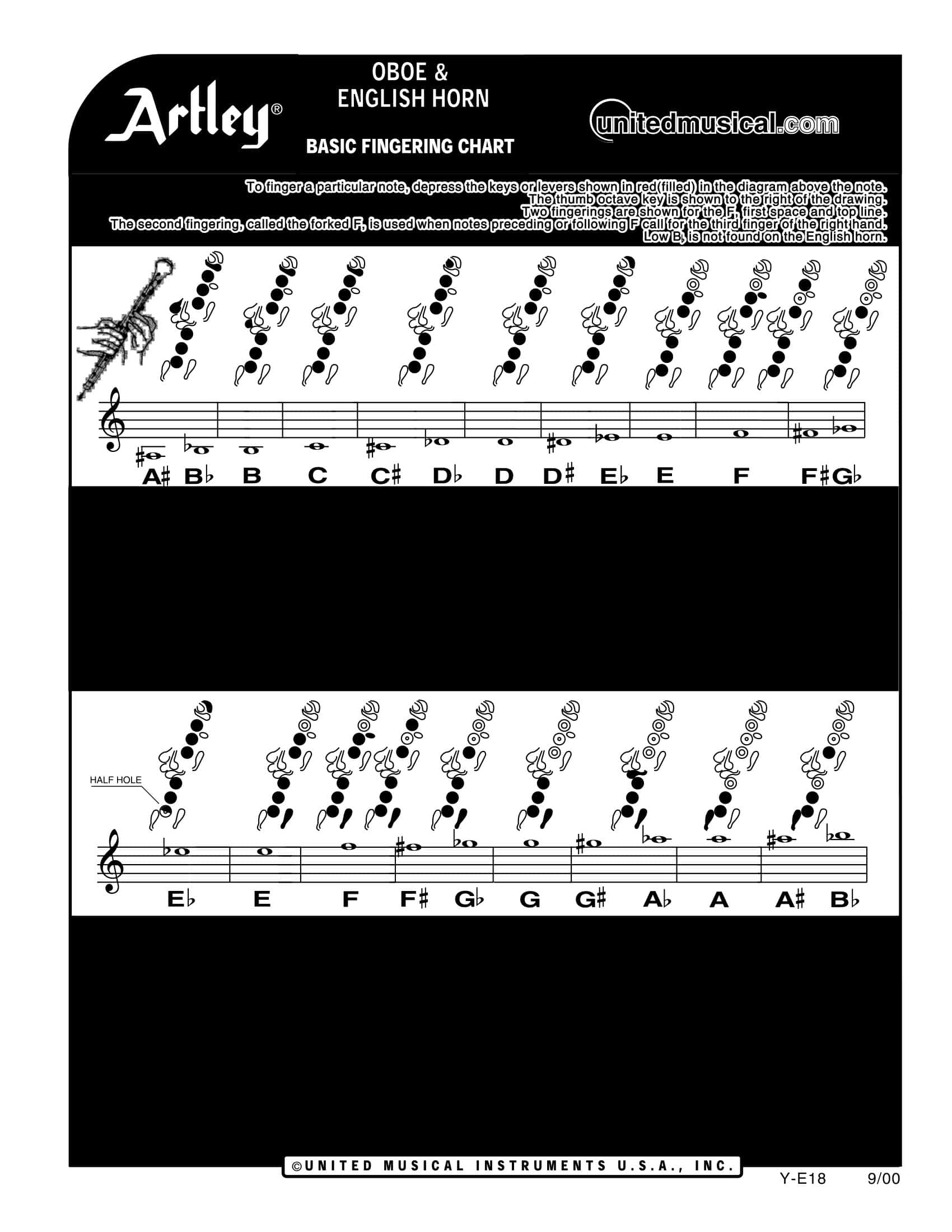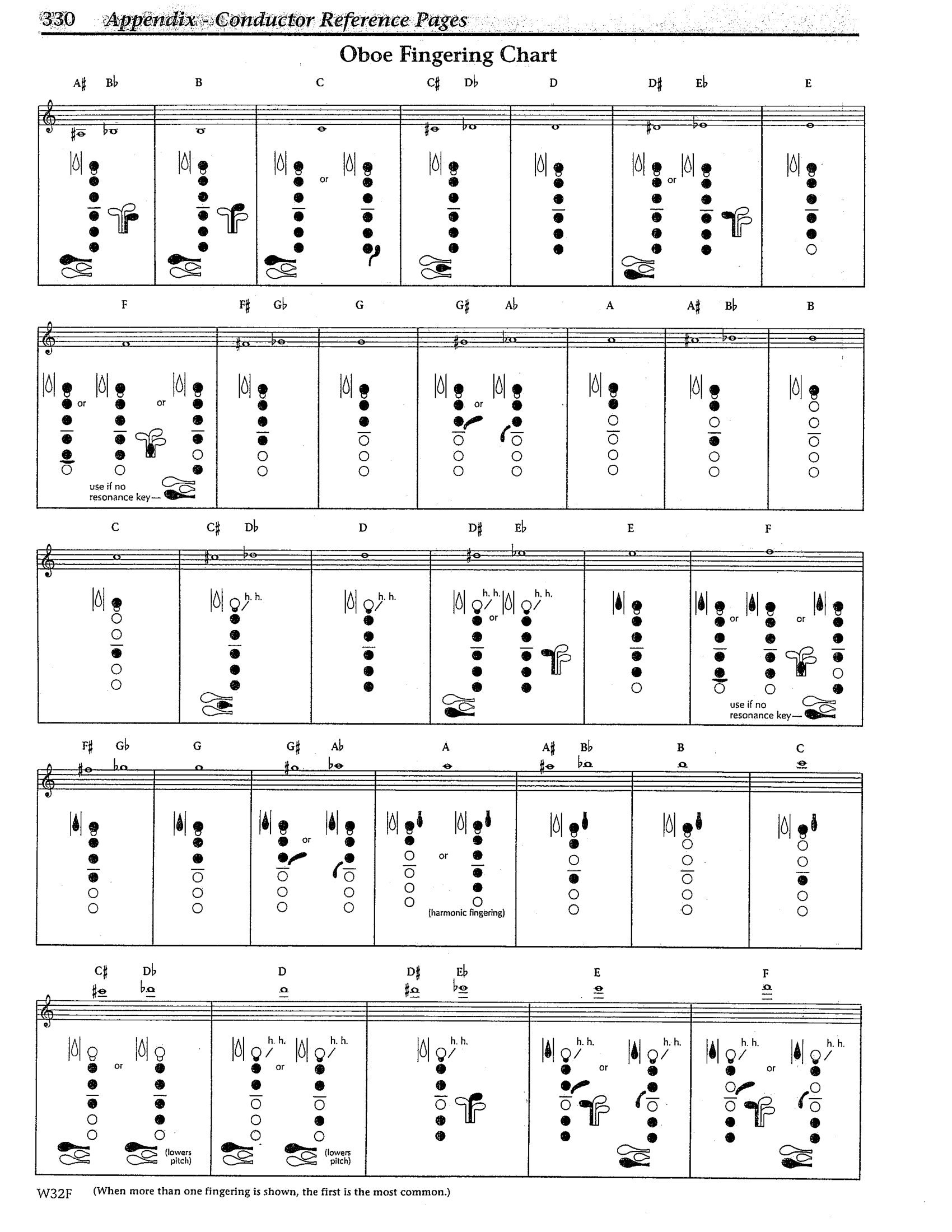Memorizing which keys to press and holes to cover for each note is a vital yet challenging part of learning the oboe. An oboe fingering chart serves as an indispensable reference tool for cementing these correlations. A fingering chart diagrams the precise finger placements on the oboe required to sound each note. With a chart, oboists can quickly look up any unfamiliar finger patterns they encounter while practicing new pieces.
Regular reference prevents struggling to recall memorized combinations. Both novice and experienced oboe players rely on fingering charts to master technique. This article explores the benefits of using a downloadable oboe fingering chart PDF to support your practice sessions. We provide a printable chart encompassing fingerings from low to high register to help you learn notes. Let’s examine how consistent use of fingering charts develops skills.
Table of Contents
What Is An Oboe Fingering Chart?

An oboe fingering chart is a visual diagram showing which keys and holes on the oboe need to be pressed or left open to produce each musical note. It provides a quick reference guide for the proper finger positions required to play the full range on the instrument. Oboe fingering charts display the chromatic scale notes on the musical staff alongside illustrations of the corresponding fingerings.
Charts use color coding to clearly indicate which keys should be closed or remain open. Both basic finger patterns and more complex trill fingerings are precisely depicted. Oboe players utilize fingering charts as a tool when learning new music, allowing them to instantly look up unfamiliar note fingerings during practice instead of memorizing every combination. The charts help reinforce the relationship between fingering patterns and the resulting pitch.
Oboe Fingering Chart Printable
The oboe produces beautiful yet challenging sounds. An oboe fingering chart PDF is invaluable for new students learning to play this double reed instrument.
The PDF illustrates finger positions for producing notes across the oboe’s range. It provides fingertip diagrams for standard fingerings as well as alternate options. Charts with audio examples let you hear proper technique for each note. PDFs also depict notations for dynamics, articulations and ornamentation.
Having a fingering chart PDF on hand prevents struggling during practice. The printable resource teaches proper hand placement and transition between notes. With repeated reference, finger positions become muscle memory. PDF charts reinforce the tactile learning that occurs during lessons. For aspiring oboists, a well-designed fingering chart is a must-have tool for building experience. The PDF format makes it easy to print and take along to rehearsals.
Oboe Fingering Basics
The Oboe Key System
The oboe is a double-reed woodwind instrument with a unique and intricate key system. Unlike some other woodwinds where open holes are prevalent, the oboe primarily uses keys and small tone holes to produce its wide range of pitches. The key system is comprised of the main keys manipulated directly by fingers, auxiliary keys for alternate fingerings, and trill keys that are used for rapid transitions between notes. The design and placement of these keys are meant to facilitate ease of playing, but mastering them requires consistent practice. Understanding the function of each key and the combination required to produce specific pitches is foundational to mastering the oboe.
Hand Positions and Posture
Proper hand positioning and posture are paramount for oboists. Due to the instrument’s delicate key system, any misplacement or undue pressure can affect tone quality and intonation. The left hand should be placed on the upper joint, with the fingers curved and relaxed, touching the keys lightly. The right hand is positioned on the lower joint in a similar manner. The thumb rests support the oboe’s weight, ensuring that the fingers remain nimble.
Posture is equally vital. Sit or stand straight, ensuring the spine remains aligned. The oboe should come to the player, not the other way around. The head should be held straight, with the instrument slightly tilted to one side. Proper posture and hand position prevent fatigue, facilitate better air support, and enable more effortless finger movement.
Half-Holing Technique
The half-holing technique is crucial for oboists, especially when transitioning between certain notes, particularly in the middle register. The name derives from the action of partially covering a hole – not entirely open, and not completely closed. This technique allows for the production of pitches that can’t be achieved with standard fingerings.
To execute half-holing, players typically use the first finger of the left hand on the first key. When transitioning to or from certain notes, the player will slightly lift this finger, allowing a controlled amount of air to escape. Achieving the correct pitch requires precision: too much or too little hole coverage can result in a sharp or flat note. Practice and experience are essential in mastering this delicate balance.
Forked Fingerings
Forked fingerings refer to a fingering technique where one or more open holes exist between closed ones. On the oboe, these fingerings are essential for producing certain pitches, especially those in the instrument’s middle range. They can sometimes produce a slightly different tone color than the regular fingerings, making them useful for artistic purposes.
However, forked fingerings can be challenging. Because of the unique sound quality and the possibility of producing unstable pitches, players must practice them diligently. Regularly reviewing fingering charts and practicing scales using forked fingerings can help in familiarizing oneself with this technique. Moreover, since the tone produced can be affected by the oboe’s make, model, and reed quality, consistent practice and awareness of the instrument’s specifics are essential.
Basic Range Fingering Chart for Oboe: Bb3 to F6
| Note | Fingering |
| Bb3 | LH little finger of left hand |
| B3 | LH C key for left hand |
| C4 | All holes closed |
| C#4 | Add RH half hole |
| D4 | Add RH 1st finger |
| Eb4 | Add LH 1st finger |
| E4 | Add RH 2nd finger |
| F4 | Add RH 3rd finger |
| F#4 | Add LH F key |
| G4 | Add RH 4th finger |
| Ab4 | Add LH Eb key |
| A4 | Add LH C# key |
| Bb4 | Add LH Bb key |
| B4 | Add LH A key |
| C5 | All holes closed, add octave key |
| C#5 | Add RH half hole and octave key |
| D5 | Add RH 1st finger and octave key |
| Eb5 | Add LH 1st finger and octave key |
| E5 | Add RH 2nd finger and octave key |
| F5 | Add RH 3rd finger and octave key |
| F#5 | Add LH F key and octave key |
| F6 | All holes closed except LH F key and octave key |
Finger Technique on the Oboe
The oboe, with its intricately designed key system and distinctive timbre, requires a comprehensive understanding of finger technique to truly master its vast tonal palette. From the basics of standard fingerings to the complexities of alternate ones, an oboist’s fingering knowledge must be both wide and deep. Three vital aspects of finger technique include trill fingerings, altissimo fingerings, and alternate fingerings.
Trill Fingerings
Trills are musical ornaments that involve the rapid alternation between two adjacent notes. The oboe’s design, with its numerous keys and levers, necessitates specific trill fingerings that differ from the standard ones. These are designed to allow the player to transition swiftly between two notes without compromising the quality of sound. Using standard fingerings for trills can result in a less fluid sound and potentially disrupt the rhythm of a piece.
For example, to perform a trill between B and C in the middle register, one might use a special side key instead of alternating between the standard B and C fingerings. It’s essential to understand that trill fingerings are designed for speed and ease, and while they facilitate quick transitions, they might not always produce the instrument’s richest tone. A thorough review of trill fingering charts and consistent practice will ensure the oboist can execute trills seamlessly.
Altissimo Fingerings
The altissimo register of the oboe refers to the notes above the instrument’s standard range, often beyond C6. Producing notes in this register requires specialized fingerings and impeccable embouchure control. These fingerings are generally more complex and can feel less intuitive to beginners, as they often involve partial hole coverage, cross-fingerings, and the simultaneous use of several keys.
The challenge with altissimo fingerings is not just in finger placement but also in voicing and air support. To produce clear and in-tune altissimo notes, the oboist must use faster air, adjust the shape of the oral cavity (or voicing), and ensure the reed is well-suited for high register playing. Oboists often spend a significant amount of time refining their altissimo technique, continually revisiting fingerings and making micro-adjustments based on their instrument, reed, and acoustic setting.
Alternate Fingerings
Every oboist, at some point in their journey, will encounter challenging passages or specific tonal requirements that standard fingerings can’t adequately address. This is where alternate fingerings come into play. Alternate fingerings offer solutions to challenges like intonation discrepancies, difficult note transitions, or the need for a particular tone color. For instance, the standard fingering for F# in the middle register might cause it to sound sharp in some contexts.
An alternate fingering can help remedy this by adjusting the pitch without compromising tone quality. Another scenario might involve a rapid passage where using standard fingerings would be cumbersome; an alternate fingering might provide a smoother transition. However, it’s essential to approach alternate fingerings with caution. They’re not always appropriate, and their use should always serve a clear musical or technical purpose. Continuous consultation with instructors, experienced peers, and comprehensive fingering charts is vital.
Troubleshooting Common Oboe Fingering Issues
The oboe, with its intricate key system and the subtleties of its double reed, is a demanding instrument to master. Fingering issues can often plague both novices and experienced players. Addressing these challenges requires a methodical approach, knowledge, and patience. Here are some common fingering issues on the oboe and suggestions for troubleshooting them:
- Unwanted Sounds or Squeaks:
- Cause: Incorrect finger placement, where a finger might be only partially covering a hole or pressing an additional key unintentionally.
- Solution: Ensure that your fingers are properly aligned with the keys and holes. Practice scales slowly, paying attention to each note transition. Also, a consistent hand position will help with precision.
- Difficulty Reaching Altissimo Notes:
- Cause: Inadequate air support, an unsuitable reed, or incorrect fingering.
- Solution: Strengthen your embouchure and provide more focused air support. Try different altissimo fingerings to see which is most effective. Consult with a reed specialist or adjust your reed to better suit high-register playing.
- Notes Not Speaking Clearly in the Lower Register:
- Cause: Leaky pads, misaligned keys, or too much pressure on the reed.
- Solution: Regularly inspect and maintain your instrument to ensure pads seal correctly and keys are aligned. Practice long tones in the lower register to improve your control and ensure you’re not biting down too hard on the reed.
- Intonation Issues:
- Cause: Incorrect finger placement, poor embouchure, or an unsuitable reed.
- Solution: Use a tuner to identify the problematic notes. Experiment with alternate fingerings to remedy sharp or flat pitches. Adjust your embouchure or consult with a reed specialist if reed issues are suspected.
- Difficulty with Rapid Finger Transitions:
- Cause: Insufficient practice, lack of finger strength or flexibility, or mechanical issues with the oboe.
- Solution: Practice challenging passages slowly using a metronome, gradually increasing the speed. Finger exercises can help improve strength and agility. Ensure the instrument’s keys move freely and are not sticking.
- Inconsistent Trills:
- Cause: Using standard instead of trill fingerings or inadequate finger strength.
- Solution: Consult a trill fingering chart to ensure you’re using the most effective fingerings. Practice trill exercises to build strength and speed.
- Issues with Half-Holing or Forked Fingerings:
- Cause: Inconsistent finger placement, where the hole is either too open or too closed.
- Solution: Practice half-holing techniques with attention to finger placement. Ensure you’re achieving the right balance between covered and open to produce the desired pitch.
- Tone Issues with Alternate Fingerings:
- Cause: Over-reliance on alternate fingerings without considering their tonal implications.
- Solution: Only use alternate fingerings when necessary for intonation or technical reasons. Always listen critically to the tone produced and ensure it matches the desired sound.
- Fingers Slipping off Keys:
- Cause: Sweaty fingers, worn-out key cork, or poor hand position.
- Solution: Ensure hands are dry. If the issue persists, consider using absorbent pads or finger cushions. Inspect the instrument for worn cork and replace if necessary. Practice proper hand positioning to ensure stability.
- Difficulty Covering Large Keys or Holes:
- Cause: Smaller hands or fingers, resulting in incomplete coverage.
- Solution: Seek guidance on ergonomic hand positioning. In some cases, modifications to the instrument, like adding extensions to keys, can be helpful.
Conclusion
Learning the oboe requires regularly referencing a fingering chart to reinforce which keys produce each note. Print out our free oboe fingering chart PDF to have a handy guide during practice sessions. Use the color-coded diagrams to cement the correlations between your finger placements and the notes that sound. Our chart covers simple beginner fingerings as well as advanced trills and alternate positions.
We also provide fingering chart PDFs for other oboe family instruments like the cor anglais and oboe d’amore. With consistent practice aided by our printable oboe fingering charts, you will quickly gain confidence playing across the full range as the patterns become second nature. Download your essential oboe fingering reference sheet today to start mastering the notes and take your performance to new heights.
FAQs
Why is an oboe fingering chart important?
It helps beginners and even more experienced players to quickly learn and recall the finger placements for various notes. This can be especially valuable when learning new pieces or trying to troubleshoot a difficult passage.
Is the fingering for oboe the same as other woodwind instruments?
While there are similarities in the basic fingerings among woodwind instruments (like the flute, clarinet, and saxophone), each instrument has its unique set of fingerings due to its specific key structure and acoustics. It’s essential to use an oboe-specific chart when learning the oboe.
Can I use an oboe fingering chart for an English horn or oboe d’amore?
Although the oboe, English horn, and oboe d’amore are from the same family and share some fingerings, they each have their distinct size, keywork, and fingerings. It’s best to use a chart specific to each instrument.
Do professional oboists use fingering charts?
Even professionals may consult fingering charts, especially for alternate fingerings, tricky passages, or when trying out a different or new instrument. It’s a valuable tool for players of all levels.


























![Free Printable Morse Code Charts [Numbers, Alphabet] 1 Morse Code Chart](https://www.typecalendar.com/wp-content/uploads/2023/09/Morse-Code-Chart-150x150.jpg)


